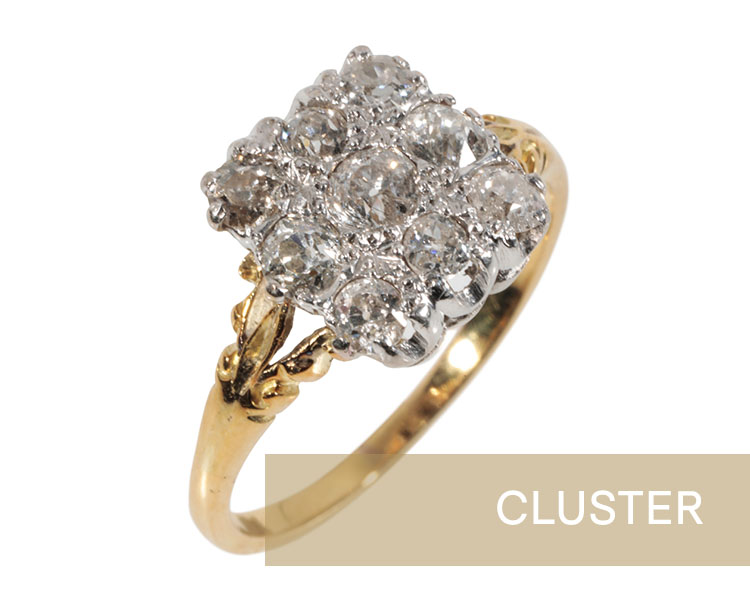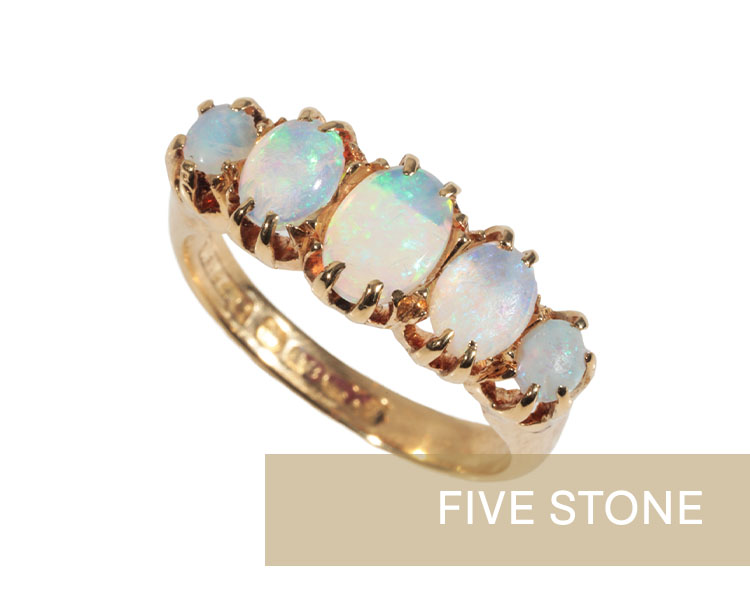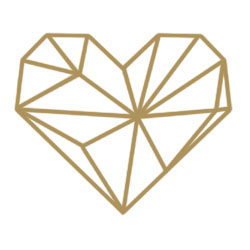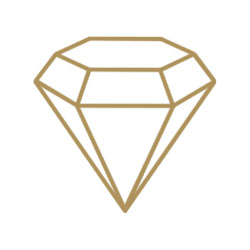Sell Your Rings Online
How To Sell Your Rings
Whether you have a diamond solitaire ring that you have inherited or a collection of Victorian rings that you have built up over the last 10 years, knowing how to sell your earrings can be somewhat difficult. Over the years, collecting habits have changed and what might have been in fashion 5 years ago may no longer be sought after.
Selling at auction used to be a good option for selling earrings, however, the average seller’s commission is now 18% and the average buyer’s commission is 25% – meaning that if you sell at auction you only get back 57% of what the buyer was willing to pay. We can help you get the most for your earrings so please get in touch.
This guide aims to help you understand what your ring is worth and what affects the value of your ring. You can also get in touch for a free valuation and no-obligation advice.
How Can You Sell Your Rings?
Are you looking to sell your ringsbut don’t know where to start? At Mark Littler LTD we make the selling process as simple as possible by handling all of the logistics, paperwork and fully insured shipping.
We can help you sell your rings in two ways:
- Through a brokered private sale
- Through specialist online auctions
Our aim is to achieve the best possible price for your jewellery; after all, you can only sell once. By giving you all of your options you can be sure you are making the right decision.
Ring Valuation Contact Form
Common Ring Types

Solitaire – The solitaire, or more specifically the diamond solitaire, is perhaps the most commercial of all ring types. Sleek and simple in design, a solitaire ring consists of a single stone set in a band of precious metal. The solitaire has endured throughout history from ancient Rome until the modern day thanks to its timeless design. Diamond solitaires are most often bought as engagement rings.

Eternity/half eternity – Eternity and half-eternity rings are commonly given to spouses on special occasions such as anniversaries. They consist of one or two rows of diamonds encircling the circumference of (or half of) a band. Eternity and half-eternity bands are used to symbolise the enduring love between a couple.

Cluster – Cluster rings typically comprise a centre stone surrounded by smaller stones, although some cluster rings do contain stones of a uniform size. The most commercial form of cluster rings are floral clusters, often styled to look like a particular flower.

Three-stone – Three-stone rings are also extremely commercial. Most commonly set with diamonds, but also seen with emeralds, rubies, and sapphires, three-stone rings consist of either three uniform stones or one large and two smaller stones set into a ring. When used as engagement rings, the three stones in the ring can be used to denote a couple’s past, present, and future.

Five stone – Five-stone rings usually consist of five stones either of uniform size or graduating in size from the centre. In relationships, five-stone rings are often gifted to the wearer upon a five-year anniversary, although they are also bought as fashion pieces.

Crossover – The crossover ring is one of the most notable jewellery innovations of the late 19th century. The ring consists of two bands overlapping each other at the front with stones set at the end of each band. Crossover rings continue to be fashionable today and are usually set with diamonds.
What Affects The Value Of Your Rings?

Designer
Jewellery is made either in anonymous workshops or by well-known designers and jewellery houses. As you can imagine, pieces that are designed by famous designers or jewellery houses such as Cartier, Van Cleef & Arpels, and Georg Jensen will command a premium over those that were mass-produced. Pieces by well-known jewellery houses have more provenance and history behind them, making them more commercial than their fashion jewellery counterparts.
Most rings that were designed and made by famous designers will bear a maker’s mark, telling you who produced the item. This information is important in valuing your pieces of jewellery. The marks can be very small, and you may not be able to read them with the naked eye. For example, on rings, the hallmark is usually seen on the inside of the shank.
The value of rings can also be affected by whether or not its design is indicative of the period that it is from. For example, a crossover ring from the 19th century, when the style was developed, should bear the style of that period.

Metal
Most rings are made from some kind of gold, silver, or platinum. Identifying the purity of the metal can help to determine the quality of the item. For example, gold comes in various different purities, with 24-carat gold being the purest, with 99.9% pure gold. As such, 24-carat gold items are considered of a higher purity than 9-carat gold items (37.5% pure gold).
Certain metals and purities are better suited to gem settings than others. For example, you would not set a 3ct emerald in a 9ct gold setting. Instead, you would use 18ct platinum, which is more durable than 9ct gold.
Silver and platinum also have different levels of purity that affect the value of items made from these metals. The purity of an item can be identified either through testing in a lab or through the hallmarks on the item. For example, a silver item with a full set of UK hallmarks can be called sterling silver.

Gemstones
If your ring is set with gemstones, there are many attributes of these gems that can affect the value of your item.
Firstly, what is the identity of the gemstone? Diamonds have always been, and remain, extremely commercial. Other stones such as tanzanite, sapphire, and emerald are also highly sought after.
Other attributes such as the cut, colour, inclusions, damage, carat weight, and clarity of the gemstone can affect the value. For example, a 1ct round brilliant natural diamond with high clarity will be more valuable than a 1ct round brilliant natural diamond with several inclusions and a chipped girdle.
There is also a disparity in value between natural gemstones and man-made gemstones. Whether or not a gemstone has been treated can also affect the value of your ring.

Condition
Of course, the condition of your ring will have an impact on value. Any dents, missing claws, scratches, etc will affect the value.
However, with jewellery, the condition of the item is more relevant to some styles than others. For example, gold is extremely malleable, and so a missing claw in a ring can be easily replaced. By contrast, items made from enamel, such as cameo brooches, can be very difficult to repair and restore.
The same can be said for different gemstones. Some gemstones are much easier to re-cut and re-polish than others.
When sending us photos of your rings please be sure to include photos of any damage to the jewellery so that we can accurately assess the condition of the item.

Age
At Mark Littler Ltd we have sold jewellery from many different time periods, from the medieval Green Hammerton Ring to modern Cartier pieces. Jewellery from certain time periods is more sought after than others. For example, jewellery from the Victorian Era (1837-1901) is more sought after by collectors than jewellery from the Retro Era (1939-1950).
Whilst this is not always the case – sometimes more modern pieces command a premium, depending on numerous factors such as the designer – the age of your jewellery can be a good indication of its rarity and value in some instances.
As mentioned above, jewellery from specific periods is always more sought after if it reflects the characteristics of the particular period. For example, Art Nouveau jewellery bearing the characteristic swirls and natural motifs will be more valuable than jewellery from the same period that does not share these features.

Form
The form that your jewellery takes can have an effect on the value of your piece due to certain types of jewellery falling in and out of fashion.
As an example, solitaire rings and stud earrings are somewhat timeless. Whereas cluster rings have somewhat fallen out of fashion in recent years.
This is not to say that cluster rings are not valuable, just less commercial at this moment in time. Although, Victorian cluster rings are sought after by collectors.
Rings, necklaces, and earrings are all very commercial, with specific styles commanding different premiums at different times in history.
How We Can Help You Sell Your Rings

Private Sale
Our brokerage service is a simple and stress-free way to sell your jewellery. We will broker the sale between you and one of our private buyers, handling every aspect of the sale on your behalf. For this service, we charge a 10 + VAT commission (12% total). This avenue is quick and easy. We will take care of everything for you.

Auction
We have built relationships with some of the country’s best specialist auctions. These industry relations help us to help you sell jewellery through the auction house that is best suited to you and your item. This is critical given the high cost of selling your items through traditional auctions. We will consign your item to the appropriate auction house for you.
Sell Rings: Expert Valuations
To make the process as simple as possible for you, we give you the opportunity to get your jewellery valued for free with our quick and easy-to-use valuation form.
Please provide as much information as possible about your item so that we can give you an accurate valuation.
Jewellery Valuation Contact Form
Postage Service
We make getting your jewellery to us simple.
We have a fully insured postage service. We send you specialist packing materials and instructions together with a pre-paid returns label so that you can ship your jewellery back to us quickly and safely.
For large collections and very high-value items, we also have a hand-courier service available.
The History of Rings
The earliest known rings date back to ancient Egypt when Egyptians would wear decorative scarab beetle rings simply threaded with gold wire. Today rings are one of the most common and easily worn pieces of jewellery.
Rings became increasingly popular amongst nobles in the medieval period, often with gems set in gold much like the Green Hammerton ring. The popularity of rings in the UK gained momentum in the late 19th century when a number of design evolutions saw the constraints set by a ring’s form relaxed by innovative jewellery designers.
The most common forms of rings include solitaire, eternity, half-eternity, cluster, three and five-stone, and crossover.
Today, the most commercial form of ring is, arguably, the diamond solitaire. Diamonds have been the gemstone of choice for engagement rings since the Victorian era when diamonds were often accompanied by other precious stones in a multi-stone setting. However, whilst other gemstone fashions come and go, diamonds are, as De Beers would say, forever. The durability of a diamond is a fitting symbol of the commitment involved in marriage. Diamond engagement rings are by the far the most popular form of a ring in the UK, with solitaires often taking precedence in order to show the stunning lustre and clarity of one singular diamond.
The 4 C’s
The 4 Cs are common terminology in the world of gemmology, and they refer to the 4 most important factors that can affect the value of a diamond but can also apply to other gemstones. Given that diamond earrings are amongst the most common on the market, these points are particularly important and will affect the value of your diamond rings. The 4 Cs are:




Clarity – The clarity of a diamond indicates how inclusion-free the diamond is. A diamond free from inclusions is commonly graded as Flawless (F). The better the clarity of the stones in your rings, the higher the value of the rings will be in comparison to similarly-sized stones of lower clarity.
Cut – The cut of a diamond refers to how deep or shallow the cut is. A well-cut diamond will direct light through the crown. A cut that is too deep or too shallow will allow light to escape. As such, a well-cut diamond, or other gemstone, will hold more value than one of a similar size but with a shallower cut. A good cut is particularly sort after in diamond solitaires, which should sparkle on the hand.
Carat – Carat refers to the carat weight of a diamond. A 1ct diamond will be worth more than a 0.95ct diamond. As such, the larger the stone the more value the piece will hold.
Diamond solitaires are extremely commercial. Therefore, diamond solitaires with large, good quality diamonds command a premium both at auction and at retail.
Colour – Colour refers to the tint within a diamond. Diamonds range from colourless to very light yellow (this is specifically in reference to colourless diamonds). There are also coloured gemstones, which refer to any gemstone that is not a diamond. The colour of these gemstones can also affect their value. For example, padparadscha sapphires – which are a beautiful orangey-pink colour, are considered the most valuable sapphires. Pale blue sapphires are generally considered the least valuable.


I highly recommend Mark Littler, who is extremely knowledgeable and went out of his way to help me sell some... artwork.read more
Well having now completed the process, I can say that Mark and his whole team are absolutely excellent. We were guided through different ways to sell different bottles. Help with packaging and transport is provided, and advice on bottle values was good.
They have now all been sold, and at very pleasing prices.
Highly recommended!read more
He completed a sale for me with his... professionalism & personal service & I will happily use him again. Thank you Mark & staff., for a five star service. Lorna Hickmanread more
I highly recommend Mark Littler if you have any unusual bottles to sell, they are the people to sell it for you.read more
Friendly professional service... throughout.
Excellent company.read more
Account Manager Hannah... Thompson completed the transaction faultlessly throughout. She was quick to establish which were the highly collectable bottles and which I would just have to enjoy drinking. I had a very good idea which bottles would fetch the best price and Hannah confirmed that for me. After putting the bottles to their database of clients, I soon had a best offer which stacked up against other vendors. On accepting the offer a courier delivered all the packing boxes the following day and we dropped everything packed to the post office. Hannah confirmed receipt and a couple of days later Mark called to confirm that he had just sent the proceeds to me - All very painless!
Many companies make a lot of promises these days but never quite deliver - Mark Littler is very much the exception!read more
Knowledgeable guy and easy to talk to! Will guide you through every step.
Highly recommendread more
Quick Online Earring Valuation
We provide free jewellery valuations. Please use the form below and provide as much information as you can about your item so that we can make sure your valuation is as accurate as possible.
Alternatively, please send photos of your jewellery (as well as any other information you can provide) to our WhatsApp .
